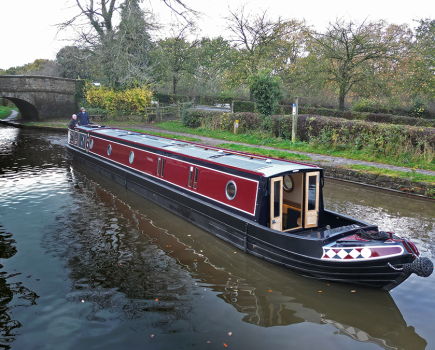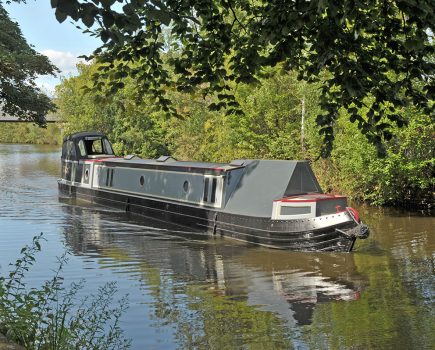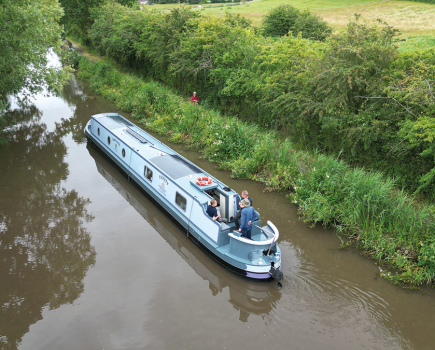If 70 is the new 60, it’s just the right age to retire and live aboard – but this boat has wisely been built with ease of use in mind

Words: Adam Porter; Pictures: Ian Thompson
The pattern of people’s lives is changing. We’re living longer, working longer and waiting for our pensions longer. In the past, plenty of people retired at 55 with a big chunk of their pension to keep them going, and a good number took up the liveaboard lifestyle. Now things are different.
Paul Barfield is an example of a new breed of liveaboard boater. At the age of 70, he’s been retired a year and had a boat built for him so he can explore the network. But this new phase of life brings its own challenges, and possibly requires a different sort of boat.

Paul has designed his boat to make life on the water easy. He wanted a manageable size so it’s just 50ft long, but he wanted as much space as possible so it has an extended fore-cabin. He and his builders, MGM, have come up with a number of ideas to make using the boat easier, so it’s certainly not conventional.
Exterior

Wey Away looks longer than its 50ft. That’s because instead of a well deck or cratch, the cabin is extended. Paul says he’s always regarded the cratch area as wasted space and would rather have it inside. It certainly means he’s achieved his aim of having a short boat without losing interior space.
The steelwork by Nick Thorpe is nicely done with smooth sides, crisp edges and details, such as a boatman’s beam across the roof and scrolls in the handrail.
The design of the shell is by MGM’s Mark Fenton, so the bow is still recognisably MGM. It’s curvy and shapely, and actually doesn’t suffer at all from the extended cabin. MGM have done a few boats recently that have had a well deck, but with the roof extending over it, and they’ve used similar tricks here to make the boat look right.

The handrails continue right to the front of the cabin, with a pronounced curve inwards. It means the cabin looks as though it’s meant to be there, not an afterthought. Most other boats we’ve looked at with extended cabins have had a big window at the front. but not this boat. Instead, the solid forward bulkhead carries the boat’s name.
The gas locker is at the bow, although the space inside is somewhat less than usual because of another of Paul’s requirements, an anchor winch that sits on the front of the boat.

Paul intends to do quite a lot of river work and, while he hopes the worst will never happen, he wanted to be prepared. He’ll be single-handing most of the time, so wanted to be able to deploy an anchor without having to leave the tiller. The winch means he’ll be able to do that, thanks to a button on the control panel at the stern. The smaller gas locker means smaller gas bottles, which, although proportionately more expensive, are lighter and easier to handle.
This is a semi-trad boat, so there’s a decent sized deck at the stern. It has storage lockers both sides, providing somewhere to sit. The board covering the engine bay is topped with a composite teak-style material and looks very smart.
There are a couple of taff seats at the stern – I’m not a fan of these because I’m a firm believer in being in front of the tiller when steering so there’s no danger of being knocked off if the rudder hits something under the water and makes the tiller swing.

The colour scheme is quite bold in its simplicity. The blue is classic and continues right up over the handrails, with no coach lines or other decoration. The name is painted in flamboyant fashion by Robin Wagg. Both the name and the legend underneath, ‘Gun’s Mouth to Pallingham 1816’ refer to Paul’s support for the Wey & Arun Canal Trust. Gun’s Mouth and Pallingham are the two ends of the canal, and 1816 was when it originally opened.
If the sides of the boat are relatively clean and simple, the roof is anything but. It’s filled with kit, including three solar panels and a folding ladder that doubles as a gang plank. There’s also a satellite dome and two internet antennas. Then, on each corner, there’s a small camera dome. These will enable Paul to see what’s going on from inside, via his TV.

With the roof being so full, having a centre line attached in the middle would have been difficult but one is essential, particularly when you’re single handing, so there are loops for attaching lines on each side of the roof, to make handling the boat easier.
Layout and fit-out
This is a reverse layout boat, with the galley situated at the stern. Next comes a Pullman dinette, followed by what Paul calls his work station – others might see it as the saloon. The walk-through shower room comes next, followed by the cabin at the bow.

The fit-out uses a combination of painted panels on the cabin sides, teamed with American ash. This gives a light, airy feel to the interior. The style of fit-out is typical of MGM, with mouldings around the painted panels and well constructed cupboards and shelves.
The floorings change as you go through the boat, starting with ceramic tiles in the galley, engineered walnut in the dinette and saloon and carpet in the cabin. Under the floor, Paul insisted on having two inches of insulation, to ensure his feet didn’t get cold.

The ceiling is routed to look like tongue and groove and was sprayed white before being fitted. There are KEF speakers set into it throughout the boat, chosen primarily not for their sound quality or prestigious name, but because they’re slim and don’t take up too much roof space.
Galley
Three steps take you from the semi-trad rear deck into the galley and the treads lift for storage. On one side there’s an electrical cupboard with controls and panels set into the door. Opposite there’s a wet cupboard – the floor lifts and Paul intends to put a bin underneath.

The galley itself is stylish thanks to a good use of colour. The worktops are made from Formica® laminate, teamed with opulent gold and red mosaic tiles. It gives a look of the Orient without being too obvious. The sink contrasts in black composite, and the tap has a head that pulls out.
Equipment includes a Thetford four-burner hob and a domestic-sized Belling oven and grill. The fridge is a 240-volt model by Beko. There’s also a small microwave in matching red.

Dinette and saloon
The Pullman dinette is raised, so there’s a good view out of the side hatches on each side. These have glazed inner doors so they can be opened even when the weather isn’t that good. The table itself has more of the red Formica® laminate.
Getting in and out of a Pullman dinette can sometimes be a little tight, but this one has a simple, clever design feature to a make it easier. The table is supported by a bar set just below the side hatch, along which it can slide, to increase the access gap. It’s an idea that plenty of people would find useful, not just those of a certain age. There’s storage in the bench seats of the dinette and under the floor of the raised section.

The saloon, or work station, is pretty small, but to solve any possible seating shortage, the backrest of the dinette can be moved to the other side of the bench, so the seating now faces the saloon. Otherwise, there’s room for just one chair – Paul has gone for a stylish German-designed racing chair.
The main feature of the saloon is a good sized desk that wraps around the corner into a book case. The design is good, and the use of colour even better, with red used to good effect.

Much of the boat’s electronics have been designed by a friend of Paul’s. MGM’s Martin Parsons says they’ve never before been asked to install so much cabling in a boat.
Shower room
The shower room is a walk-through design to maximise space. The door from the saloon slides back into the bulkhead and is released with a push catch. The walls and floor are tiled, but the ceiling is covered in Formica® laminate, with more of the same colour making the top of the basin unit.

The basin is a round white one and the unit has four drawers. There’s a feature mirror above across the corner of the room. Paul was determined he’d be able to see properly to shave, so a spotlight has been put on the ceiling, to light him not the mirror.
The good sized quadrant shower has sparkly laminate walls and an extractor fan in the ceiling. The loo is a Jabsco macerating unit, with the holding tank under the bed, along with the water tank.

Between the shower room and the cabin there’s a two foot-long corridor that provides cupboards both sides. On one side, they house a Kenwood washing machine, while opposite there’s a Beko tumble drier. Paul wanted the appliances close to the bedroom, where dirty clothes are taken off. The spaces above are used as wardrobes with hanging space.
Cabin
The cabin takes up the front of the boat, in the extended section. Often when we’ve seen beds in spaces like this, the owners have taken the opportunity to have a bed that’s the full width of the boat, but that means crawling into bed from the foot and putting a sheet on the mattress can be really difficult, especially as you get older.

So in this case, the bed is offset to one side. The mattress has been made to fit, as the boat curves in on one side. This set up means the bed is easier to get in and out of, and you can easily reach across to make it. Additionally, there’s room for a bedside cabinet. There’s also a bookshelf above the bed.
A set of side doors in the cabin provide a means of escape, with ladder-style steps. The portholes here are smaller than in the rest of the boat at 11 inches across rather than 14.

Technical
In one sense, this boat is quite straightforward technically. There’s a Beta 43 engine, which should be reliable, easy to maintain and provide sufficient power for rivers. There are five 110ah domestic batteries, plus one for the engine and another at the bow for the anchor winch. A 240-volt supply comes from a Victron 2.5kW inverter, and there’s a 3.5 kW TravelPower engine-driven generator.
Much of the additional technical equipment has been designed and sourced by a friend of Paul’s, an expert in such things. He ordered the three 250-Watt solar panels and an MPPT controller direct from China. He also sourced the internet antennas and router, and the security system, which includes the four security cameras.

A VHF radio is installed for use on big rivers and heating is provided by a Webasto diesel boiler.
On the water

Mark Fenton designs his hulls with nice long swims, so it’s no surprise this boat handles very well. It responds quickly to the tiller and turns well. Winding was easy, there’s no bow thruster (Paul thought he wouldn’t need one, given it’s a relatively short boat), but there is a tube fitted in case he changes his mind.
The stern deck has plenty of room for crew and the lockers make ideal seats. The engine is quiet and the Morse control well placed, but the positioning of the control panel inside the boat means you have to make a bit of an effort to see the dials. From the tiller, the extended cabin means you have more idea where the front of the boat is.
Conclusion

Let’s start by admitting that boats with extended front cabins aren’t everyone’s cup of tea. For many boaters, a well deck is an essential feature they wouldn’t want to be without.
The extended cabin gives the boat a very non-traditional look, but this boat is an object lesson in fitting as much as possible into as small a space as practical. The owner wanted a shorter boat for ease of handling and mooring, but he still wanted a decent amount of living space inside. That’s certainly been achieved.
What’s more, the interior is stylish, combining Paul’s eye for colour and design with MGM’s craftsmanship. It’s incorporated many little details to help Paul live aboard and explore the network well into retirement.
And the price is pretty good too. MGM’s price for a boat like this is around £110,000. That includes the shell, the fit-out, the engine, and all the basic electrics, everything you need. Paul says he’s added extras (such as the solar panels, the multiple security cameras and his high tech internet system) costing at least £10,000. Obviously lots of people could live without some or all of those things.
So here we have a very bespoke boat, on a good shell, with a high quality finish, for a reasonable price. And when you’re starting a new phase of your life at whatever age that sounds like a winning combination.
____________________
You may also like:
Me & My Boats: Deborah Mendel-Lion
Boat Test: Elsie Alice by Soar Valley Steel Boats
How to make sure your narrowboat is heating up properly
Image(s) provided by:
Archant







